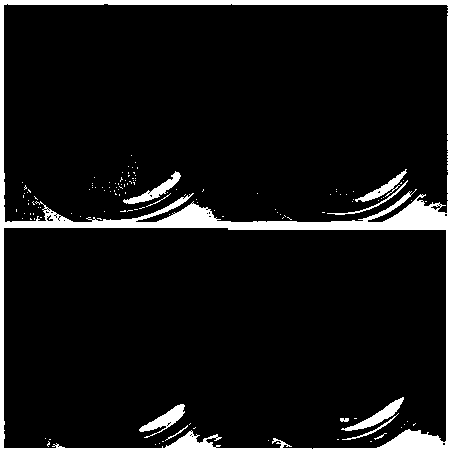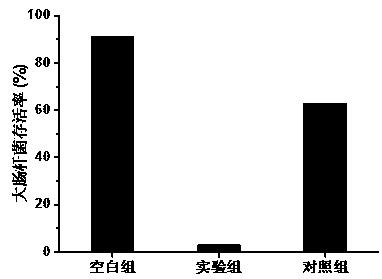Preparation method and application of copper-doped carbon quantum dots
A technology of carbon quantum dots and copper doping, applied in the direction of botany equipment and methods, applications, chemical instruments and methods, etc., can solve the problems of less research on the photocatalytic performance of carbon quantum dots, and achieve high-efficiency antibacterial effects
- Summary
- Abstract
- Description
- Claims
- Application Information
AI Technical Summary
Problems solved by technology
Method used
Image
Examples
Embodiment 1
[0020] 1. Preparation of copper-doped carbon quantum dots: take 1.6gNa 2 [Cu(EDTA)] and 0.1 g of ascorbic acid were mixed evenly, placed in a corundum boat with a lid, and roasted in a high-temperature tube furnace at 300 °C for 2 h. After the roasting was completed, the black product was ground and dissolved in 100 mL of deionized water, and ultrasonicated for 20 min; then the black suspension was centrifuged at 15,000 rpm for 15 min, and the supernatant was passed through a 0.22 μm filter membrane; the filtrate was dried in a vacuum oven at 60 °C for 24 h to obtain copper-doped carbon quantum dots.
[0021] 2. Test of photocatalytic antibacterial performance of copper-doped carbon quantum dots on Escherichia coli: inoculate Escherichia coli (ATCC 11775) in LB medium, at 37°C, 200r min -1 Under the conditions of shaker culture for 12h, the bacterial solution was diluted gradiently to determine the concentration of the bacterial suspension to be 10 6 CFU / mL; take two groups ...
Embodiment 2
[0025] 1. Preparation of copper-doped carbon quantum dots: take 2.0gNa 2 [Cu(EDTA)] and 0.3 g of ascorbic acid were mixed evenly, placed in a corundum boat with a lid, and roasted in a high-temperature tube furnace at 300 °C for 3 h. After the roasting was completed, the black product was ground and dissolved in 100 mL of deionized water, and sonicated for 30 min; then the black suspension was centrifuged at 10,000 rpm for 20 min, and the supernatant was passed through a 0.22 μm filter membrane; carbon quantum dots.
[0026] 2. Test of photocatalytic antibacterial performance of copper-doped carbon quantum dots on E. coli: the effect is similar to Example 1. After 45 min of visible light irradiation, the bactericidal rate of copper-doped carbon quantum dots on E. coli reached 100%.
Embodiment 3
[0028] 1. Preparation of copper-doped carbon quantum dots: Take 1.8g Na 2[Cu(EDTA)] and 0.2 g of ascorbic acid were mixed evenly, placed in a corundum boat with a lid, and roasted in a high-temperature tube furnace at 300 °C for 2.5 h. After the roasting was completed, the black product was ground and dissolved in 100 mL of deionized in water, and ultrasonicated for 25 min; then the black suspension was centrifuged at 12,000 rpm for 18 min, and the supernatant was passed through a 0.22 μm filter membrane; the filtrate was dried in a vacuum oven at 62°C for 24 h to obtain copper-doped carbon quantum dots.
[0029] 2. Test of photocatalytic antibacterial performance of copper-doped carbon quantum dots on E. coli: the effect is similar to Example 1. After 45 min of visible light irradiation, the bactericidal rate of copper-doped carbon quantum dots on E. coli reached 100%.
PUM
 Login to View More
Login to View More Abstract
Description
Claims
Application Information
 Login to View More
Login to View More - R&D
- Intellectual Property
- Life Sciences
- Materials
- Tech Scout
- Unparalleled Data Quality
- Higher Quality Content
- 60% Fewer Hallucinations
Browse by: Latest US Patents, China's latest patents, Technical Efficacy Thesaurus, Application Domain, Technology Topic, Popular Technical Reports.
© 2025 PatSnap. All rights reserved.Legal|Privacy policy|Modern Slavery Act Transparency Statement|Sitemap|About US| Contact US: help@patsnap.com


